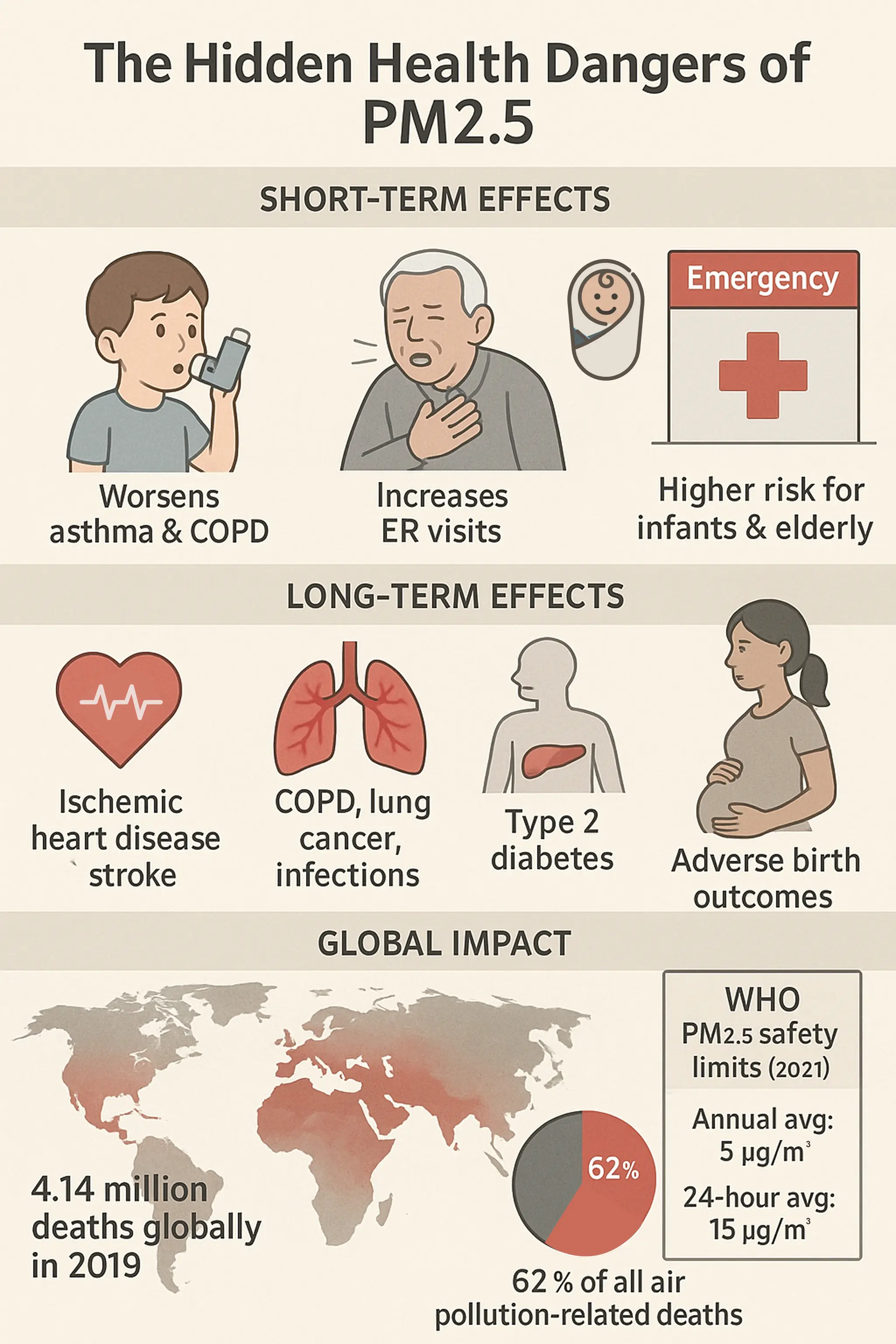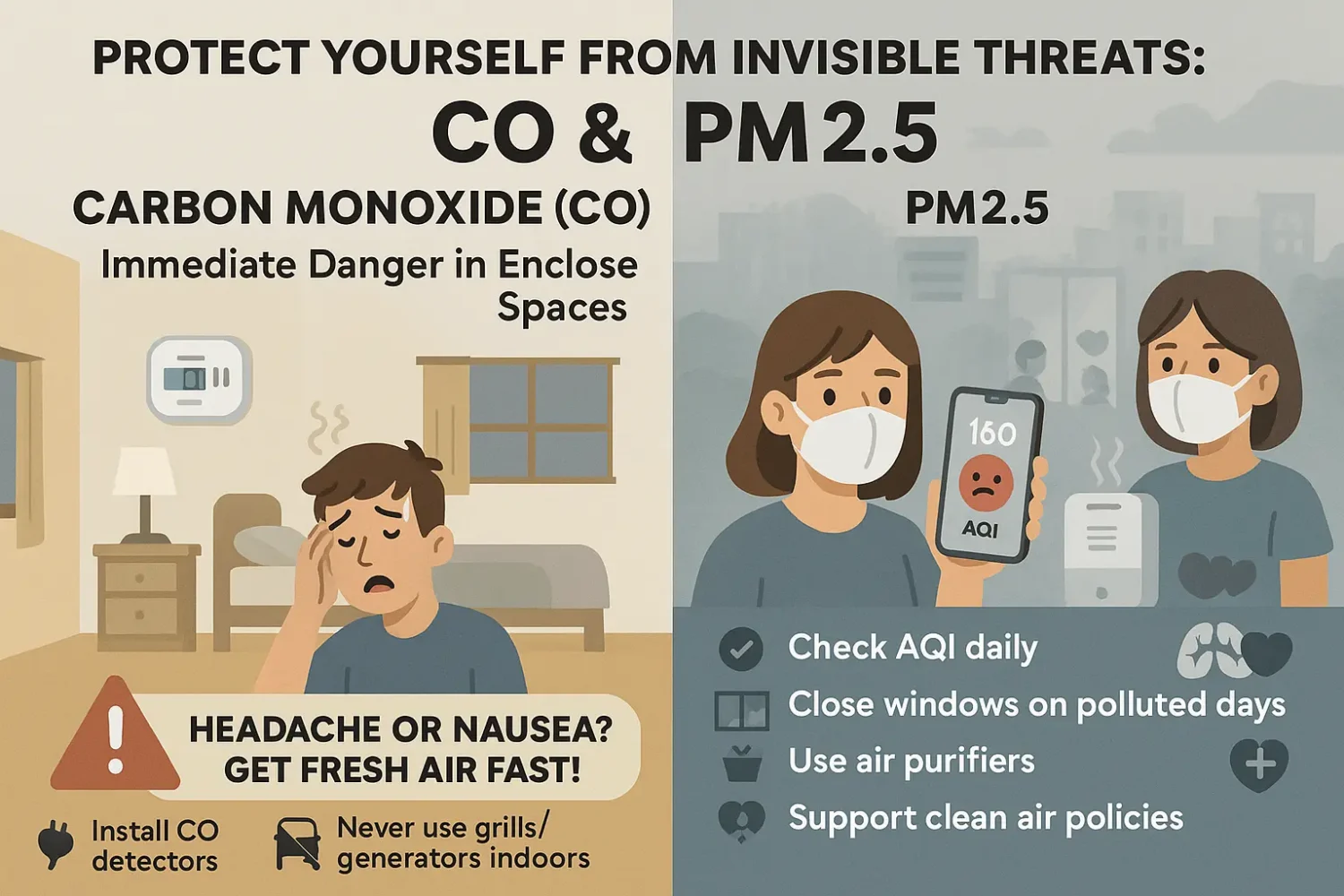The air around us carries many invisible pollutants and particles. Without even noticing, we breathe in these substances every day, many of which can harm our health. Two major pollutants that raise serious health concerns are and carbon monoxide (CO). But which one is more dangerous to breathe? Before we compare their risks, it’s important to understand what each of them is.
PM2.5 refers to particulate matter that is 2.5 micrometres in diameter or smaller. To put that in perspective, a human hair is about 50 to 70 micrometres wide, so PM2.5 is roughly 30 times smaller. Because of their tiny size, these particles can slip past our body’s natural defences, travel deep into the lungs, and even enter the bloodstream. They are commonly produced by vehicle exhaust, industrial emissions, power plants, and wildfires. Moreover, their widespread presence and ability to cause lasting internal damage make them a major public health concern.
, on the other hand, is a colourless, odourless gas produced when fuels like wood, coal, or gasoline don’t burn completely. It can be found in car exhaust, cigarette smoke, and in homes with faulty heating systems or poorly ventilated generators. What makes CO especially dangerous is that it’s undetectable without special equipment, earning it the nickname “the silent killer.” Without warning, it can build up in enclosed spaces and lead to serious poisoning or even death.
Now that we know what PM2.5 and CO are, we can begin to explore their health impacts—and ultimately determine which poses the greater danger to human health.
How Dangerous is Carbon Monoxide for Your Health?
Firstly, know the health effects of inhaling Carbon Monoxide (CO). When you inhale carbon monoxide, it can bind with your haemoglobin in your blood and result in carboxyhemoglobin that affects the oxygen transfer. This can result in different symptoms depending on exposure levels and duration.
At low concentrations, healthy individuals might experience fatigue, while those with heart disease may feel chest pain. Higher concentrations of CO can cause impaired vision, coordination issues, headaches, dizziness, confusion, and nausea. Besides, it can mimic flu-like symptoms that resolve upon leaving the exposure area. At very high levels, CO can be fatal, with death possible within minutes to hours in severe cases.

WHO CO Exposure Limits:
The WHO (World Health Organization) recommended limits are:
- 9-10 ppm for no more than 8 hours
- 25-35 ppm for no more than 1 hour
Health Impact (2021 data – The Lancet Public Health):
- 28,900 global deaths from unintentional CO poisoning
- Mortality rate: 0.366 per 100,000
- Higher risk among men and older adults
Exposure Risk:
- Occurs in enclosed spaces with combustion (e.g., faulty heaters, running vehicles)
- Greater risk in colder climates due to heating use
- Less widespread than PM2.5, so lower overall public health impact
What are the Health Effects of PM2.5?
PM2.5 (fine particulate matter) poses serious health risks through both short-term and long-term exposure. Unlike carbon monoxide, its impact is widespread and persistent, affecting large populations across the globe.

Short-Term Exposure:
Exposure to PM2.5 for even a single day (up to 24 hours) can worsen respiratory conditions like asthma and chronic obstructive pulmonary disease (COPD). This often leads to:
- Increased hospital admissions and emergency visits
- Higher risk of death, particularly among infants, children, older adults, and people with pre-existing conditions
The California Air Resources Board highlights that PM2.5 is responsible for the largest share of global health effects from air pollution, as shown by the WHO’s Global Burden of Disease Project.
Long-Term Exposure:
Over time, regular exposure to PM2.5 is linked to several chronic and life-threatening diseases, including:
- Ischemic heart disease
- Stroke
- Lung cancer
- COPD
- Lower-respiratory infections
- Type 2 diabetes
- Adverse birth outcomes
A 2024 study in Scientific Reports estimated that PM2.5 from residential heating and road traffic in Europe leads to about 72,000 and 35,000 excess deaths each year, respectively—mainly due to carbon-rich particles.
Global Impact:
According to the State of Global Air report, PM2.5 was responsible for 4.14 million deaths globally in 2019. That’s 62% of all deaths linked to air pollution, with Asia and Africa carrying the highest burden.
WHO Guidelines:
To protect health, the World Health Organization (WHO) updated its PM2.5 limits in 2021:
- Annual average: 5 μg/m³
- 24-hour average: 15 μg/m³
However, these limits are frequently exceeded in urban areas, especially in developing countries—making PM2.5 a constant health threat for millions.
Comparative Analysis of Carbon Monoxide (CO) or PM2.5: Which Is More Dangerous?
To understand which pollutant—carbon monoxide (CO) or PM2.5—is more dangerous, we need to look at several key factors: how deadly they are, how common they are, their long-term health effects, and who is most at risk. Here’s a side-by-side comparison:
| Aspect | Carbon Monoxide (CO) | PM2.5 |
| Immediate Danger | High – Can be fatal within minutes or hours in enclosed spaces with poor ventilation. | Low – Doesn’t usually cause immediate death, but can trigger asthma attacks or heart events. |
| Long-Term Impact | Limited – Mainly causes acute poisoning, with less evidence for chronic illness. | High – Linked to chronic diseases like heart disease, lung cancer, and diabetes. |
| Global Mortality | 28,900 deaths in 2021 from accidental CO poisoning. | 4.14 million deaths in 2019 from PM2.5 exposure (indoor and outdoor sources combined). |
| Prevalence | Situational – Often linked to faulty appliances or enclosed spaces with combustion. | Widespread – Common in urban and industrial areas; affects large populations daily. |
| Vulnerability | Dangerous for anyone, especially in enclosed spaces. | Especially harmful to children, elderly, and people with existing health problems. |
While carbon monoxide poses a serious immediate risk—especially in poorly ventilated spaces—its impact is usually limited to specific incidents. PM2.5, on the other hand, is far more widespread and causes long-term health damage across large populations.
According to State of Global Air data, PM2.5-related deaths have risen by about 23% over the last decade, mainly due to growing populations, ageing demographics, and increasing pollution levels, especially in parts of Asia.
Although both pollutants are harmful, PM2.5 has a much larger public health impact globally.
What should you do to protect yourself from Carbon Monoxide (CO and PM2.5 exposure?
Based on these findings, it’s important to protect yourself from both types of pollution.

For Carbon Monoxide (CO):
- Install carbon monoxide detectors at home, especially near bedrooms.
- Never use gas stoves, grills, or generators indoors.
- Make sure heating systems are properly maintained and vented.
- If you feel symptoms like headaches, dizziness, or nausea, get fresh air immediately and seek medical attention—these could be signs of CO poisoning.
For Fine Particulate Matter (PM2.5):
- Check your local Air Quality Index (AQI), especially on days with high pollution.
- When air quality is poor, stay indoors with windows closed.
- Use air purifiers and avoid outdoor activities, especially if you’re in a high-risk group like children, the elderly, or those with heart or lung conditions.
- Support policies that aim to reduce air pollution, like stricter emission standards and clean energy initiatives. These efforts help protect everyone in the long run.
Conclusion
To sum up, carbon monoxide (CO) is a serious short-term threat, especially in certain situations, but fine particulate matter (PM2.5) poses a greater overall risk because it affects more people and contributes to millions of deaths each year from long-term illnesses.
The good news is that CO exposure can mostly be prevented with the right safety measures. PM2.5, however, is harder to avoid because it’s more widespread, especially in cities with high pollution.
By understanding the dangers of both pollutants, we can make smarter choices, push for cleaner air, and take steps to protect our health and the health of our communities.